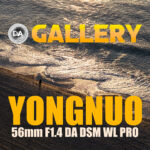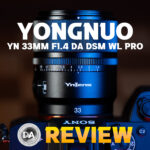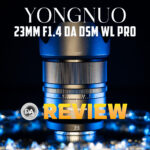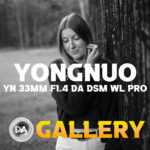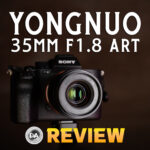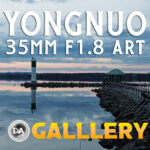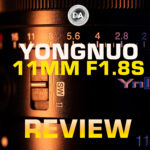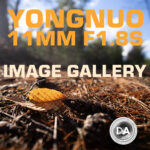
Yongnuo’s “Commander” series of lenses has thus far been consistently good. I’ve previously reviewed first an 11mm F1.8, then the first of the trio of faster primes at standard focal lengths. First came the 33mm F1.4, then the 23mm F1.4, and now we will cover the telephoto end of the equation in the new Yongnuo YN 56mm F1.4S DA DSM WL Pro. This series has come with a rich feature set, nice build, good autofocus, and quality optical performances. The YN 56mm delivers a full frame equivalent of 84mm, or roughly an 85mm lens on your Sony E (tested here), Nikon Z, or Fuji X-mount APS-C cameras and their 1.5x crop factor. Is the 56mm a worthy addition to this series and worth the asking price of about $275 USD? You can find out my full thoughts by watching the video review below…or reading on in the text review.
Follow Me @ YouTube | Patreon | Instagram | Facebook | DA Merchandise | Flickr | 500px | X
Thanks to Yongnuo for sending me a review sample of this lens. As always, this is a completely independent review. *The tests and most of the photos that I share as a part of my review cycle have been done with the APS-C mode (26MP) of my Sony a7RV camera.
__________________________________________________________________________________________________
Here’s a look at my reviews of this series of wirelessly connected lenses:
- YN 11mm F1.8 DA DSM Pro WL
- YN 23mm F1.4 DA DSM Pro WL
- YN 33mm F1.4 DA DSM Pro WL
- YN 56mm F1.4 DA DSM Pro WL
__________________________________________________________________________________________________
The 56mm (85mm) is a popular focal length because it sits as perhaps the most versatile focal length for portraits. It is long enough and fast enough to strongly blur out backgrounds, but not so long that it is difficult to work with in smaller spaces.

Like many of these inexpensive 56mm lenses, the YN 56mm is sharp but can’t match a full frame 85mm lens when it comes to the quality of bokeh. Fuji’s expensive XF 56mm F1.2 WR (my review here) is the exception to that rule, but it isn’t inexpensive, either. And, while an F1.4 lens has the same light gathering potential whether it be an APS-C or full frame lens, the crop factor of APS-C does make for less shallow depth of field. The two shots below were taken about three hours apart (so somewhat different lighting), but it does illustrate how much more shallow the depth of field is for the full frame 85mm lens on the right though the magnification is actually higher for the YN 56mm lens on the left.

That being said, the Yongnuo is very capable of producing very shallow depth of field shots with highly blurred out backgrounds.

The YN 56mm (as we’ll call it for brevity) is a very feature rich lens, as we’ll see, but one of those innovations requires purchasing an inexpensive (under $25) remote control unit that leverages a 2.4gz wireless module built into the lens. Far from just being a basic remote control unit, this remote control allows you to remotely control focus, do aperture racking, set up A-B focus pulls, and more basic functions like take photos, start video, and do whatever you have the function button programmed to do. It’s a very clever little device particularly for video functions as you can do some of these key movements without touching the lens and introducing vibration.

The 11mm F1.8 was the first of a new series of lenses from Yongnuo that they call the “Commander Series”, and this 56mm is part of a secondary trio of lenses of 23mm, 33mm, and 56mm F1.4 options that all share very similar design elements.

If you don’t speak Yongnuo, let me break down what those letters mean in the 56mm F1.4S DA DSM WL Pro lens designation. In many ways this follows the Fuji naming convention which puts a list of features right in the name.
- S = Sony, or Sony E-mount
- DA = APS-C
- DSM = Digital Stepping Motor
- WL = Wireless control
- Pro = upscale build, additional features
The YN 56mm has a lot going for it, including a great focal length, great functionality, and fairly strong image quality.

There are also a few weaknesses along with many strengths, and we will break down it all in our review.
Build and Handling
The 56mm focal length has seen a lot of releases over the past few years, including a variety of releases from both first party brands (Fuji) and the many third party brands on the market, like Sigma, Viltrox, Tokina, Sirui, and TTArtisan. The YN 56mm shows well in this class, however, with a very reasonable price and more features than almost all of the competing lenses. This does come at the cost of some weight, however, as the Yongnuo is fairly heavy at 368g (13.1oz) in the group. It has similar external dimensions to the 23mm and 33mm, but weighs just a bit more due to the larger glass elements in this longer focal length. Fuji’s own 56mm F1.2 WR lens is a fair bit heavier (445g), but it also has a faster maximum aperture. The YN 56mm is very similar in size to the recently released YN 23mm F1.4.

That visual similarity does change when you introduce the hoods, however, as the hood for the 56mm is considerably deeper.

Like the 33mm F1.4, the YN 23mm is 69mm in diameter (2.7″) x 87mm (3.4″) in length, which is about 13mm longer than the Fuji 56mm lens but the Fuji lens is considerably wider in diameter at 79.4mm. The front filter threads are a common 58mm size which is shared across the whole trio of new lenses from Yongnuo.

You’ll note the “Wi-Fi” radio signal logo next to the lens designation. Yongnuo continues to be the only company I know of utilizing this, though I have seen Bluetooth in a few Viltrox lenses.

While some competing lenses have an aperture ring, the Yongnuo adds several other features, including the ability to declick the aperture, a custom/function button, and a two mode-custom switch that allows you tweak the behavior of the ring.



As noted, this is a very feature rich little lens. We have a function/focus hold button on the left side of the barrel. That function can be assigned from within the camera.

There’s also a custom switch that allows for a few different functions. In one mode, it serves a an AF | MF switch, with mode I being AF while mode II will switch to MF.

The manual focus ring has a nice feel to it overall, though the weight is on the lighter side. There is no obvious stepping, however, so focus moves fairly smoothly when using the MF ring. You can program the custom switch to this function by turning the camera off, setting the position to II, and then holding the custom button down. Then power the camera back on, and you will feel a click in the lens.

To use the optional remote control, turn the camera off, set the switch position to I, and then hold down the function button while turning on the camera. Now position “I” will mean that wi-fi is turned on for remote communication while position “II” will mean that it is turned off. I would recommend keeping it in the off position when it is not in use. I haven’t noticed a battery drain issue, but you can essentially assure that this won’t be an issue by turning it off.
The YN 56mm also has a robust approach to aperture control. It has an aperture control ring with one third stop detents between F1.4 and F16 along with an automatic position that can be accessed past F16 (there is a firmer detent there to keep from accidental switches between the two). The feel of the clicks is good, with clear delineation of each position but without being rough.

There is also a declick option with a switch on the right side of the barrel. Click that switch and you can smoothly rack through the aperture, which is particularly useful for video work.

The aperture iris itself has 9 rounded blades to help ensure circular specular highlights when stopped down, though, in practice, this doesn’t work that well. Even by F2 you can clearly see the shape of the aperture blades in specular highlights (series has F1.4, F2, and F2.8).



The lens barrel is made of metal, and it has a nice, anodized black satin finish. The lens design is very clean and modern.

A deep petal-shaped lens hood is included. While it isn’t anything particularly special, it is sturdier than some and bayonets into place with a reasonably precise feel.
There is a USB-C port for firmware updates covered by a small rubber gasket. Be careful when pulling it out, as it is small and wouldn’t be hard to lose. It’s also nearly impossible to pry out unless you have a small prying tool, like a very small flat screwdriver.

The USB-C port will allow for quick and easy firmware updates, which is a smart move by Yongnuo considering that they are a third party lens maker, so they may have to rely on firmware updates to maintain compatibility with cameras in the future. The lens does include a USB-C cable in the box in case you don’t have one.
There is a metal lens mount with a weather sealing gasket attached. Yongnuo also claims a fluorine coating on the front element to resist fingerprints and moisture.

One area where the Fuji 56mm F1.2 and Sigma 56mm F1.4 have a clear advantage is in minimum focus distance. Those lenses can focus as closely as 50cm (producing a 0.14x level of magnification), but the YN 56mm can only focus as closely as 57.9cm. The Viltrox 56mm F1.7 splits the difference at 55cm, though it shares the maximum magnification figure of 0.11x, which looks like this:

In real world use, I would say that the magnification level, while not particularly high, is enough to allow you to really isolate subjects.

The remote control has a small LCD screen and is primarily controlled through the main knob that can be clicked to switch through various functions and rotated to control those functions. There are two buttons for programming A and B focus pulls (just set the focus position, hold down the corresponding button for one second, and either “A” or B” where appropriate will light up. There’s a power switch on the side and also a custom button on the side that corresponds to the custom button on the lens. Clicking it will enable whatever function is programmed to that button on the lens.

Using the remote isn’t always intuitive, but if you’ll spend a few minutes with the included user manual it becomes easy enough to use. Range is up to 30 meters, which definitely gives you some flexibility for controlling off camera.
The fact that the Yongnuo is both the cheapest ($268 USD) and most feature rich lens in the bunch of F1.2 and F1.4 options is pretty impressive, and that has given this whole series a unique advantage relative to other options. I’m not sure if Yongnuo’s market share is growing through these lenses, but it probably deserves to.
Autofocus and Video
Yongnuo has equipped this whole series, including the 56mm F1.4, with what they call a “digital stepping motor” (DSM). I’m not entirely sure how a digital stepping motor varies from a typical stepping motor, so I suspect this is mostly their own marketing language. Focus speed is pretty good, and I’ve gotten good accuracy even in narrow depth of field situations, like in the shot of this pigeon on the beach at F1.4:


You can see the precision of focus in this shot.
There is almost no noise to be heard even if I put my ear next to the lens barrel. There is the slightest buzz from the motor, but so quiet as to be nearly undetectable. Focus speed is good, too, with near instant transitions from one focus point to another either indoors or out. The fact that focus speed matches the other lenses in the series despite being a longer focal length is great for Yongnuo.
I found that real world precision was good, whether shooting human subjects, like this speaker in church.

…or when tracking animal subjects, including birds in flight.

For stills I’ve been impressed with the overall quality of focus with the lenses from this series. The fact that we’re getting such great autofocus from even smaller third party lensmakers like Yongnuo these days is impressive.
I tested focus for portraits at a variety of focus distances, and focus locked on immediately and accurately in all of them.



In my formal tracking test the Eye AF tracking box stayed locked onto the subject as I moved around throughout the frame. I suspect that most photographers should be happy with the focus accuracy and speed of the YN 56mm.
As with most third party lenses, if your goal is tracking fast action, you might want to go with a Sony lens (not that there are many in this focal range), but for most people in most situations, autofocus for stills was pretty great.
Video AF
On the video front I found mostly good results. Focus pulls were smooth with minimal steps, though I did see a tiny final adjustment at times. Focus breathing is more pronounced at this longer focal length than at the shorter ones.
The YN 56mm was mostly okay with my hand test where I alternately block and then remove the camera’s view of my face with my hand. Transitions were smooth, though I did find that I needed to keep my hand in place an extra beat or two before focus would transition to it. Reactiveness was a little slow.
Video footage was generally good, though fringing can be pretty obvious in certain situations. Here’s a freeze frame from one of my clips:

Focus seemed stable in my static shots and didn’t jump around. Overall I would call focus stable but not reactive, which is pretty consistent with what I’ve seen from this series of lenses.
Yongnuo 56mm F1.4 Image Quality Breakdown
The YN 56mm has an optical design of 10 elements in 9 groups. Half of these are exotic elements, including high refractive elements, low dispersion, and ultra low dispersion elements.

The MTF chart shows a fairly consistent result across the frame, with a few minor dips and rises. The F8 graph levels out some of the dips and rises, and it is one of the rare lenses where the corner performance (at least on the sagittal plane) is better than the center performance. This may be a budget lens, but that’s solid sharpness.

The biggest practical negative I saw was some fairly obvious fringing in certain situations. This showed up not only in transitions but also in some high contrast situations, like on this flying gull, cropped from a larger shot.

That fringing was very evident on my chart as well, so just be aware that this is probably the most significant optical issue with the YN 56mm. That green fringing in particular is quite obvious.

Lateral chromatic aberrations (LaCA) are much less of an issue, with only very minimal amount of fringing near the edges of the frame.

Often people are interested in the amount of coverage APS-C lenses provide on full frame cameras. This is not some kind of “stealth full frame lens”, as most of the additional full frame image circle is obscured by the “mechanical vignette” of the lens not covering the full frame portion of the lens.

There’s not enough additional coverage available to warrant using it on full frame and cropping. This is an APS-C lens, period. As is almost always the case, you would be better served by buying a full frame lens if you want full frame coverage.
There’s some obvious pincushion distortion, though it does correct in a linear fashion.

I used a -10 to correct the pincushion distortion, which is enough to be noticeable without correction, but vignette is fairly low, requiring just a +32 to correct, or about one stop.
So how about resolution and contrast? My tests have been done on a 26MP APS-C mode of my Sony a7RV. Here’s the test chart:

Here are F1.4 crops at roughly 200% from across the frame (center, mid-frame, and lower right corner).



That’s good sharpness, though there are a number of existing 56mm lenses that could match that, including the Sigma, Viltrox 56mm F1.7, and the aforementioned Fuji.
Still, there’s a solid amount of detail, though you can see some fringing in the high contrast light.


In lower contrast situations I felt like the detail looked more compelling.


Stopping down to F1.8 makes relatively little change (a bit more contrast), with a little more obvious contrast at F2.

This crop from a portrait shot at F1.8 shows good detail; I suspect most would be happy with that level of detail.

By 2.8 I see a good performance right off into the corners.

You’ll see a bit more improvement as you stop down into the prime landscape apertures like F5.6-F8:

That means that the YN 56mm is a very nice landscape lens, providing good detail and contrast across the frame.



Here’s another shot that shows the solid detail across the frame.



Sharpness peaks around F5.6, with F8 being very close to the same. I’ll show the other corner now, which also demonstrates a good quality of centering in the lens that I tested.

Diffraction will start to soften the image after that, with a mild amount at F11 but a more obvious amount by F16. Diffraction isn’t as obvious at the 26MP level on Sony, but expect this to be more pronounced if you are using a Fuji 40MP sensor.

Thus far the only 56mm that I’ve really been wowed by when it comes to bokeh rendering is the Fuji 56mm F1.2 WR, but in the right scenario I think the bokeh is pretty good from the YN 56mm.

I don’t consider the “right situation” to be one with prominent specular highlights, however, because there is a fair bit of fringing in those highlights.

This image is a good example of two sets of strengths for the lens. first of all, the quality of the blur of this rather complicated background is good.

But secondly, the real world sharpness at F1.4 is great.

Flare resistance is mostly good. I had no flare related issues shooting into this bright rising sun over the Atlantic.

This shot that puts the sun up in the corner is a little more impacted, however.

Overall I think this is a pretty average performance.
Yongnuo’s optical glass is fairly good but not top notch. Colors were mostly good, however, though not quite as special as what you’ll get from higher end lenses.



But it’s important to remember that this is a lens that costs under $270. I would say that the overall rendering is pretty great for the money. When compared to other lenses in this price class I think the optics are competitive and the feature set is clearly much more robust than what competing lenses offer. If you’d like to see more image samples, check out the image gallery here.
Conclusion
The Yongnuo 56mm F1.4S DA DSM WL Pro is a pretty attractive option if you’re looking for a 85mm equivalent lens on your APS-C camera. It is a feature rich, focuses well, has weather sealing, and delivers a pretty strong optical performance, too. The price is more similar to an F1.8 lens than an F1.4 lens, which doesn’t hurt, either.

It is priced as a mid-tier lens, but it probably outperforms that. The Sigma 56mm F1.4 DN stands as perhaps a superior lens optically, though far less feature rich, while the Viltrox AF 56mm F1.7 AIR is the budget competitor that has fewer features but every bit as good of optics…and costs nearly $100 less.

But if you want a lens that has the features and the performance, it’s hard to criticize the Yongnuo YN 56mm F1.4 DA DSM WL Pro. It does a lot of things well, and, outside of more fringing than what I would like, doesn’t really have any crippling optical flaws. If you are looking for this particular focal length, the Yongnuo YN 56mm F1.4 well worth consideration.

Pros:
- Nice looking lens with nice build
- USB-C port for firmware updates
- Good manual focus ring and experience
- Very feature rich
- Weather sealed
- Declickable aperture
- Wireless remote control
- Custom button
- Autofocus motor is quiet and fast
- Good sharpness wide open
- Excellent sharpness stopped down
- Fairly good bokeh
- Great price to performance ratio
Cons:
- Some fringing issues
- Gasket for USB-C is hard to remove and easy to lose
- Low magnification
_________________________________________________________________________
GEAR USED:
Purchase the Yonguno 56mm F1.4 @ B&H Photo | Amazon | Amazon Canada | Amazon UK | Amazon Germany
Purchase the Yonguno 23mm F1.4 @ B&H Photo | Amazon | Amazon Canada | Amazon UK | Amazon Germany
Purchase the Yongnuo 33mm F1.4 @ B&H Photo | Amazon | Amazon Canada | Amazon UK | Amazon Germany
___________________________________________________________________
Purchase the Sony a7RV @ B&H Photo | Adorama | Amazon | Camera Canada | Sony Canada | Amazon Canada | Amazon UK | Amazon Germany
__________________________________________________________________
Purchase the Sony a6600 @ B&H Photo | Amazon | Camera Canada | Amazon Canada | Amazon UK | Amazon Germany | Ebay
Purchase the Sony a6400 @ B&H Photo | Amazon | Amazon Canada | Amazon UK | Amazon Germany | Ebay
_________________________________________________________________
Want to support this channel? Use these affiliate links to shop at: B&H Photo | Amazon | Adorama | Camera Canada | Amazon Canada | Amazon UK | Ebay | Make a donation via Paypal
Buy DA Merchandise https://bit.ly/TWIMerch

Keywords: Yongnuo, YN, 56mm, F1.4, Yongnuo 56mm F1.4, DSM, WL, F1.4, Pro, APS-C, Review, Sony a6700, a6000, a6400, Sony a7RV, 23mm, 33mm, Wireless, Review, Hands On, Dustin Abbott, Real World, Comparison, Sharpness, Bokeh, Flare Resistance, Autofocus, Image Quality, Sample Images, Video, Photography, let the light in, weathersealing, #letthelightin, DA

